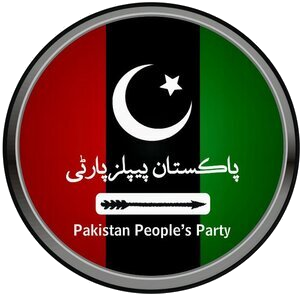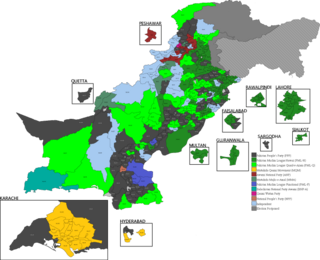
Mian Muhammad Nawaz Sharif is a Pakistani businessman and politician who served as the Prime Minister of Pakistan for three non-consecutive terms. He is the longest-serving prime minister of Pakistan, having served a total of more than 9 years across three tenures. Each term has ended in his ousting.

The Pakistan People's Party is a centre-left political party in Pakistan. It is currently the first-largest party in the Senate and third-largest party in the National Assembly. The party was founded in 1967 in Lahore, when a number of prominent left-wing politicians in the country joined hands against the military rule of president Muhammad Ayub Khan, under the leadership of Zulfikar Ali Bhutto. It is affiliated with the Socialist International. The PPP's platform was formerly socialist, and its stated priorities continue to include transforming Pakistan into a social-democratic state, promoting egalitarian values, establishing social justice, and maintaining a strong military. The party, alongside the Pakistan Muslim League-Nawaz and the Pakistan Tehreek-e-Insaf, is one of the three largest political parties of Pakistan.

The Pakistan Muslim League (Nawaz) (Urdu: پاکستان مسلم لیگ (ن), abbr.PML(N) or PML-N) is a centre-right, conservative liberal political party in Pakistan. It is currently the third-largest party in the Senate. The party was founded in 1993, when a number of prominent conservative politicians in the country joined hands after the dissolution of Islamic Democratic Alliance, under the leadership of former Prime Minister Nawaz Sharif. The party's platform is generally conservative, which involves supporting free markets, deregulation, lower taxes and private ownership. Although the party historically supported social conservatism, in recent years, the party's political ideology and platform has become more liberal on social and cultural issues; however, members have been accused of using Islamist populist rhetoric. Alongside the Pakistan Tehreek-e-Insaf (PTI) and Pakistan People's Party (PPP), it is one of the three major political parties of the country.

Asif Ali Zardari is a Pakistani politician serving as the 14th president of Pakistan since 10 March 2024. He is the president of Pakistan People's Party Parliamentarians and was the co-chairperson of Pakistan People's Party.

Iftikhar Muhammad Chaudhry is a Pakistani jurist who served as the 20th Chief Justice of Pakistan over three non-consecutive terms from 29 June 2005 to 11 December 2013.

Chaudhary Aitzaz Ahsan is a Pakistani politician and lawyer. He served two times as the Leader of the House in the Senate of Pakistan from 1994 to 1997 and again from 2012 to 2015. He also served as the Leader of the Opposition in the Senate. He was elected a member of the Senate of Pakistan from Punjab in 1994. His tenure ended in March 2018.

General elections were held in Pakistan on 18 February 2008 to elect members of the 13th National Assembly and the four Provincial Assemblies.
The 12 May Karachi riots, also known as Black Saturday riots, were a series of violent clashes between rival political activists in Karachi. The violence resulted in 58 killings of ethnic Pashtuns. The unrest began as the recently suspended chief justice Iftikhar Muhammad Chaudhry arrived at the Jinnah International Airport on 12 May 2007. Gunfights and clashes erupted across the provincial capital as lawyers, Pakistan Peoples Party (PPP), Awami National Party (ANP), Pakistan Tehreek-e-Insaf (PTI), and Pashtunkhwa Milli Awami Party (PMAP) activists, who supported the judge, and the pro-government Muttahida Qaumi Movement (MQM) activists took to the streets against each other. Pakistan Muslim League Quaid-e-azam PMLQ and MQM party workers, with support from president and military dictator Gen. Pervez Musharraf, were accused of launching highly coordinated attacks against lawyers, ANP, PTI, PPP, and news channels, especially Aaj News. Government machinery was used to block all major roads. Police was accomplice and a silent spectator to the violence. News media was attacked at Guru Mandir when MQM activists began firing at Aaj News headquarters which was shown on live television.
Ali Ahmad Kurd, is a Pakistani lawyer, who served as the president of the Supreme Court Bar Association of Pakistan and was one of the most prominent figures in the Lawyers' Movement of 2007. He opposed the military government of Pervez Musharraf, who ruled the country from 1999 to 2008.

Chief Justice of Pakistan Iftikhar Muhammad Chaudhry was made a "non-functional Chief Justice" on 9 March 2007. In so acting, President Pervez Musharraf invoked two main clauses of the Constitution of Pakistan. The suspension evoked a nationwide popular mass protest movement led by lawyers, known as the Lawyers' Movement and eventually culminated with the Pakistan Long March.

A state of emergency was declared by President of Pakistan Pervez Musharraf on 3 November 2007 which lasted until 15 December 2007, during which the Constitution of Pakistan was suspended. When the state of emergency was declared, Musharraf controversially held both positions of President and Chief of Army Staff. He later resigned as army chief 25 days into the emergency on 28 November. The state of emergency and its responses are generally attributed to the controversies surrounding the re-election of Musharraf during the presidential election on 6 October 2007, including his holding of both offices of President and Chief of Army Staff at the time.
Malik Mohammad Qayyum was a Pakistani lawyer who was Senior Advocate Supreme Court and Attorney General of Pakistan. He was replaced by Senator Latif Khosa when President Pervez Musharraf resigned on 18 August 2008. He became Attorney General following the resignation of Makhdoom Ali Khan. He was a Judge of the Lahore High Court, which he resigned from after a phone transcript of his was released in which he was alleged to be approached by the then Prime Minister Nawaz Sharif's government to fix judgement in a case before him involving Benazir Bhutto. Qayyum denied that the voice in the telephone conversation was his. Agencies have examined the tapes and have expressed their concern that they could have been doctored although no final verdict is available.

Latif Khosa is a Pakistani lawyer and politician who is an advocate in the Supreme Court of Pakistan. He served as the 37th Governor of Punjab from 2011 to 2013. He is the incumbent Member of National Assembly Pakistan from NA-122 Lahore since 10 February 2024. He was a senator from 2003 to 2009, the attorney general of Pakistan in 2008 to 2009 and the Federal advisor of Information Technology & Telecommunication from 2009 to 2010. Khosa also remained a member of the Pakistan Bar Council and served as its Executive Committee's chairman. He co-authored an electoral fraud report with former prime minister Benazir Bhutto shortly before her assassination in December 2007. Khosa had been one of Bhutto's aides. Khosa joined PTI in 2023.
Bhurban Accord was a political agreement signed by two of Pakistan's biggest political powers, the Pakistan Peoples Party (PPP) and the Pakistan Muslim League (Nawaz) (PML-N) and was signed by co-chairman of the PPP Asif Ali Zardari and PML-N leader Nawaz Sharif it was signed on 8 March 2008 in PC Bhurban in the province of Punjab.

Zaheer-ud-din Babar Awan, is a Pakistani politician, senior lawyer, author, analyst, columnist, and leftist writer who served as Adviser to Prime Minister for Parliamentary Affairs from April 2020 to 10 April 2022, and before that as the Federal Law Minister in the cabinet of former Prime Minister Yousaf Raza Gillani. He also served as a junior Pakistani Senator of Punjab Province from 2012 to 2017. Later he joined PTI to serve as Member Executive Council of PTI.

An indirect presidential election was held on 6 September 2008 in Pakistan. The Electoral College of Pakistan – a joint sitting of the Senate, National Assembly and Provincial Assemblies – elected a new president after the resignation of President Pervez Musharraf. As required by the constitution, Muhammad Mian Soomro automatically became acting president on 18 August 2008, upon the resignation of Musharraf. The constitution required that a new president be elected by Parliament within 30 days; Soomro was considered loyal to Musharraf, and it was considered certain that he would be replaced in that election.
The National Reconciliation Ordinance was a controversial ordinance issued by the former President of Pakistan, General Pervez Musharraf, on 5 October 2007. It granted amnesty to politicians, political workers and bureaucrats who were accused of corruption, and wanted to leave country for their own profit embezzlement, money laundering, murder, and between 1 January 1986, and 12 October 1999, the time between two states of martial law in Pakistan. It was declared unconstitutional by the Supreme Court of Pakistan on 16 December 2009, saving the country from political crisis.

Tassaduq Hussain Jillani is a Pakistani judge who served as the 21st Chief Justice of Pakistan from 2013 to 2014. He previously served as a justice of the Supreme Court of Pakistan from 2004, after being nominated as a justice of the Lahore High Court by Prime Minister Benazir Bhutto in 1994.

The Provisional Constitutional Order Judges case, refers to cases heard and decided by the Pakistan Supreme Court pertaining to the High Court and Supreme Court judges who took their oath of offices under the Provisional Constitutional Order in 2007. On 3 November 2007, then-President Pervez Musharraf declared a Provisional Constitutional Order, which declared a state of emergency and suspends the Constitution of Pakistan. Under this emergency law, all High court judges, including the Supreme Court justices, were asked to take oath under this Provisional Constitutional Order. Those who didn't were placed under effective house arrest. A seven-member bench issued a restraining order on the same day, barring the government from implementing emergency rule and urging other government officials to not help do so.

The History of the Supreme Court of Pakistan, organised by the Chief Justice of Pakistan, follows from its constitutional establishment in 1947 till its recent events. The Supreme Court of Pakistan is the highest appellate court of the country and court of last resort— the final arbiter of the law and the Constitution.














